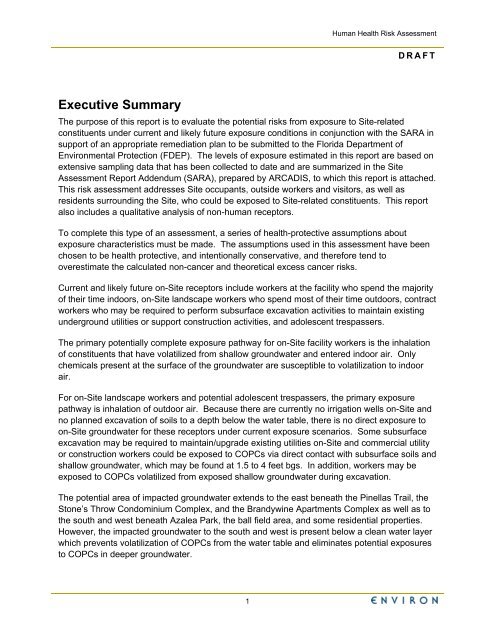Human Health Risk Assessment - Raytheon
Human Health Risk Assessment - Raytheon
Human Health Risk Assessment - Raytheon
Create successful ePaper yourself
Turn your PDF publications into a flip-book with our unique Google optimized e-Paper software.
Executive Summary<br />
1<br />
<strong>Human</strong> <strong>Health</strong> <strong>Risk</strong> <strong>Assessment</strong><br />
DRAFT<br />
The purpose of this report is to evaluate the potential risks from exposure to Site-related<br />
constituents under current and likely future exposure conditions in conjunction with the SARA in<br />
support of an appropriate remediation plan to be submitted to the Florida Department of<br />
Environmental Protection (FDEP). The levels of exposure estimated in this report are based on<br />
extensive sampling data that has been collected to date and are summarized in the Site<br />
<strong>Assessment</strong> Report Addendum (SARA), prepared by ARCADIS, to which this report is attached.<br />
This risk assessment addresses Site occupants, outside workers and visitors, as well as<br />
residents surrounding the Site, who could be exposed to Site-related constituents. This report<br />
also includes a qualitative analysis of non-human receptors.<br />
To complete this type of an assessment, a series of health-protective assumptions about<br />
exposure characteristics must be made. The assumptions used in this assessment have been<br />
chosen to be health protective, and intentionally conservative, and therefore tend to<br />
overestimate the calculated non-cancer and theoretical excess cancer risks.<br />
Current and likely future on-Site receptors include workers at the facility who spend the majority<br />
of their time indoors, on-Site landscape workers who spend most of their time outdoors, contract<br />
workers who may be required to perform subsurface excavation activities to maintain existing<br />
underground utilities or support construction activities, and adolescent trespassers.<br />
The primary potentially complete exposure pathway for on-Site facility workers is the inhalation<br />
of constituents that have volatilized from shallow groundwater and entered indoor air. Only<br />
chemicals present at the surface of the groundwater are susceptible to volatilization to indoor<br />
air.<br />
For on-Site landscape workers and potential adolescent trespassers, the primary exposure<br />
pathway is inhalation of outdoor air. Because there are currently no irrigation wells on-Site and<br />
no planned excavation of soils to a depth below the water table, there is no direct exposure to<br />
on-Site groundwater for these receptors under current exposure scenarios. Some subsurface<br />
excavation may be required to maintain/upgrade existing utilities on-Site and commercial utility<br />
or construction workers could be exposed to COPCs via direct contact with subsurface soils and<br />
shallow groundwater, which may be found at 1.5 to 4 feet bgs. In addition, workers may be<br />
exposed to COPCs volatilized from exposed shallow groundwater during excavation.<br />
The potential area of impacted groundwater extends to the east beneath the Pinellas Trail, the<br />
Stone’s Throw Condominium Complex, and the Brandywine Apartments Complex as well as to<br />
the south and west beneath Azalea Park, the ball field area, and some residential properties.<br />
However, the impacted groundwater to the south and west is present below a clean water layer<br />
which prevents volatilization of COPCs from the water table and eliminates potential exposures<br />
to COPCs in deeper groundwater.

















